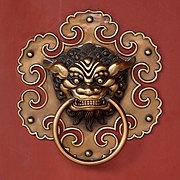Siong Lim Temple
[4] The name of the monastery refers to the twin groves of sala trees located at the Bodh Gaya in India, where Lord Buddha was believed to have attained Enlightenment.In 1950s, the temple area was reduced to about 20,000 m² when part of the land was acquired by the Singapore Improvement Trust for public housing.[6] The temple was gazetted a national monument on 17 October 1980, symbolising the social and cultural roots of the early Chinese immigrants.In 1910, the buildings of the temple started to deteriorate due to termite infestations, harsh tropical weather and wear and tear caused by worshippers.To prevent termite infestation, termite-resistant timber was imported from Sarawak, and custom-made roof tiles that were more water-resistant were ordered from Japan.The doors to the main hall feature carved lattice motifs of flowers, birds and Chinese symbols of longevity, while its exterior walls are decorated with tortoise-shell designs.
MahayanaNational Monument of SingaporeToa PayohSingaporeCoordinatesBuddhismGlossaryOutlineHistoryTimelineThe BuddhaPre-sectarian BuddhismCouncilsSilk Road transmission of BuddhismDecline in the Indian subcontinentLater BuddhistsBuddhist modernismDharmaConceptsFour Noble TruthsNoble Eightfold PathDharma wheelFive AggregatesImpermanenceSufferingNot-selfDependent OriginationMiddle WayEmptinessMoralityRebirthSaṃsāraCosmologyBuddhist textsBuddhavacanaEarly TextsTripiṭakaMahayana SutrasPāli CanonSanskrit literatureTibetan canonChinese canonPost-canonPracticesThree JewelsBuddhist Paths to liberationFive preceptsPerfectionsMeditationPhilosophical reasoningDevotional practicesMerit makingRecollectionsMindfulnessWisdomSublime abidingsAids to EnlightenmentMonasticismLay lifeBuddhist chantPilgrimageVegetarianismNirvāṇaAwakeningFour StagesPratyekabuddhaBodhisattvaBuddhaTraditionsTheravādaMahāyānaHinayanaChineseVajrayānaTibetanNavayanaBuddhism by countryBhutanBrazilCambodiaIndonesiaMalaysiaMongoliaMyanmarNew ZealandRussiaSri LankaTaiwanThailandVietnamtraditional Chinesesimplified ChineseBuddhistPan Island ExpresswayLow Kim PongQing Ming FestivalHokkienPe̍h-ōe-jīpinyinBodh GayaLord BuddhaEnlightenmentBuddhist templeFujiannational monumentIstana ParkCHIJMESjiaotuThe Straits TimesBuddhism in SingaporeChinese BuddhismAng Chee Sia Ong TempleBuddha of Medicine Welfare SocietyBuddha Tooth Relic Temple and MuseumFoo Hai Ch'an MonasteryHai Inn TempleHong San SeeHua Giam Si (also Fa Hua Monastery)Jin Long Si TempleKong Meng San Phor Kark See MonasteryKwan Im Thong Hood Cho TempleTou Mu Kung TempleHumanistic BuddhismDharma Drum MountainBuddha's Light International AssociationTzu Chi Singapore